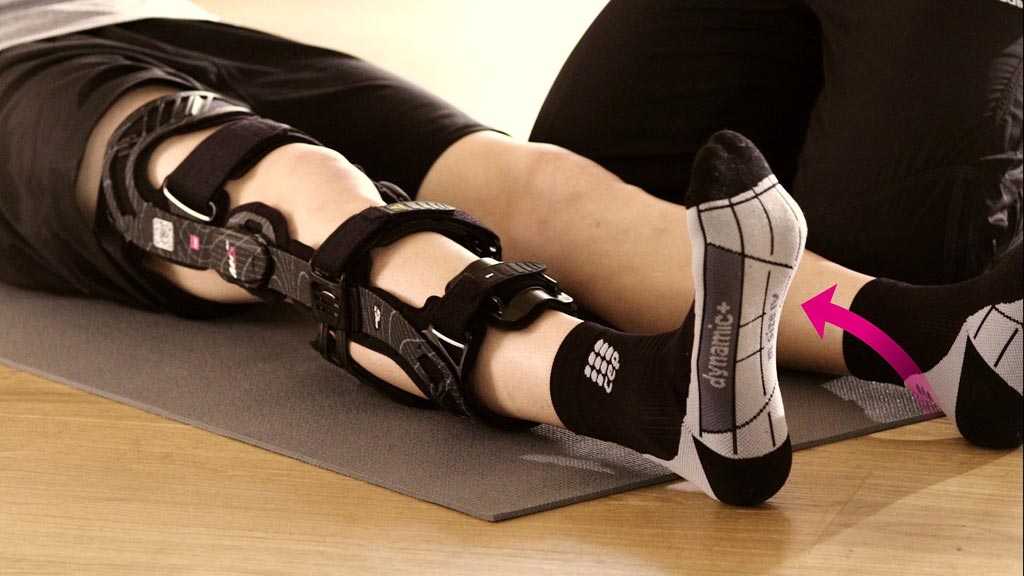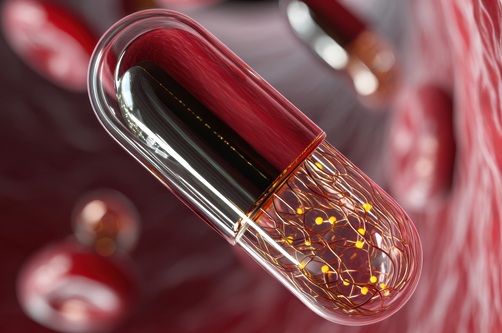Dynamic Brace Stabilizes Knee after Surgery
|
By HospiMedica International staff writers Posted on 01 Feb 2018 |

Image: An adjustable brace stabilizes the knee prior to and following surgery (Photo courtesy of medi).
An innovative orthopedic knee brace provides reliable stabilization of the knee joint following injuries involving the posterior cruciate ligament (PCL).
The medi (Bayreuth, Germany) M.4s is a dynamic, 4-point, rigid-frame brace designed to provide varus or valgus pressure relief and limit extension and flexion of the PCL via an adjustable pad that holds the tibia in the desired location by active pressure. A customizable tension dial dynamically protects and relieves tension on the PCL by providing a safe and secure fit, while flat construction and non-slip pads help increase patient compliance and boost mobility. The new brace also molds to the shape of the shinbone and mimics knee movement with the proprietary Physioglide hinge.
Preoperative indications for use include severe medial or lateral gonarthrosis (at least level III) combined with ligament instability; unicompartmental relief before high tibial osteotomy (HTO); relief of painful stress fractures, such as in the tibia head; strong overloading of the medial or lateral compartment of the knee; and permanent relief, when surgery is contraindicated. Postoperative indications include cartilage surgery, chondroplasty, meniscus refixation, and displacement osteotomy, all with required postoperative relief of the medial or lateral compartment.
“It is particularly helpful that I can exert force on the tibia from behind with the brace, as it is a simple mechanism,” said Professor Phillip Schoettle, MD, PhD, medical director of the department of orthopedics and traumatology at ISAR Kliniken (Munich, Germany). “The patient also understands the mode of action straight away. This means that this function also helps the patient understand why he is wearing the brace.”
The PCL is one of the four major ligaments of the knee, designed to stabilize the articulating bones, particularly the femur and the tibia, during movement by rotating, so that the anterolateral section stretches in knee flexion, but not in knee extension, while the posteromedial bundle stretches in extension, rather than flexion. The PCL connects the posterior intercondylar area of the tibia to the medial condyle of the femur, a configuration that allows the PCL to resist forces pushing the tibia posteriorly relative to the femur.
Related Links:
medi
The medi (Bayreuth, Germany) M.4s is a dynamic, 4-point, rigid-frame brace designed to provide varus or valgus pressure relief and limit extension and flexion of the PCL via an adjustable pad that holds the tibia in the desired location by active pressure. A customizable tension dial dynamically protects and relieves tension on the PCL by providing a safe and secure fit, while flat construction and non-slip pads help increase patient compliance and boost mobility. The new brace also molds to the shape of the shinbone and mimics knee movement with the proprietary Physioglide hinge.
Preoperative indications for use include severe medial or lateral gonarthrosis (at least level III) combined with ligament instability; unicompartmental relief before high tibial osteotomy (HTO); relief of painful stress fractures, such as in the tibia head; strong overloading of the medial or lateral compartment of the knee; and permanent relief, when surgery is contraindicated. Postoperative indications include cartilage surgery, chondroplasty, meniscus refixation, and displacement osteotomy, all with required postoperative relief of the medial or lateral compartment.
“It is particularly helpful that I can exert force on the tibia from behind with the brace, as it is a simple mechanism,” said Professor Phillip Schoettle, MD, PhD, medical director of the department of orthopedics and traumatology at ISAR Kliniken (Munich, Germany). “The patient also understands the mode of action straight away. This means that this function also helps the patient understand why he is wearing the brace.”
The PCL is one of the four major ligaments of the knee, designed to stabilize the articulating bones, particularly the femur and the tibia, during movement by rotating, so that the anterolateral section stretches in knee flexion, but not in knee extension, while the posteromedial bundle stretches in extension, rather than flexion. The PCL connects the posterior intercondylar area of the tibia to the medial condyle of the femur, a configuration that allows the PCL to resist forces pushing the tibia posteriorly relative to the femur.
Related Links:
medi
Latest Surgical Techniques News
- Robotic Assistant Delivers Ultra-Precision Injections with Rapid Setup Times
- Minimally Invasive Endoscopic Surgery Improves Severe Stroke Outcomes
- Novel Glue Prevents Complications After Breast Cancer Surgery
- Breakthrough Brain Implant Enables Safer and More Precise Drug Delivery
- Bioadhesive Sponge Stops Uncontrolled Internal Bleeding During Surgery
- Revolutionary Nano Bone Material to Accelerate Surgery and Healing
- Superior Orthopedic Implants Combat Infections and Quicken Healing After Surgery
- Laser-Based Technique Eliminates Pancreatic Tumors While Protecting Healthy Tissue
- Surgical Treatment of Severe Carotid Artery Stenosis Benefits Blood-Brain Barrier
- Revolutionary Reusable Duodenoscope Introduces 68-Minute Sterilization
- World's First Transcatheter Smart Implant Monitors and Treats Congestion in Heart Failure
- Hybrid Endoscope Marks Breakthrough in Surgical Visualization
- Robot-Assisted Bronchoscope Diagnoses Tiniest and Hardest to Reach Lung Tumors
- Diamond-Titanium Device Paves Way for Smart Implants that Warn of Disease Progression
- 3D Printable Bio-Active Glass Could Serve as Bone Replacement Material
- Spider-Inspired Magnetic Soft Robots to Perform Minimally Invasive GI Tract Procedures
Channels
Critical Care
view channel
CPR Guidelines Updated for Pediatric and Neonatal Emergency Care and Resuscitation
Cardiac arrest in infants and children remains a leading cause of pediatric emergencies, with more than 7,000 out-of-hospital and 20,000 in-hospital cardiac arrests occurring annually in the United States.... Read more
Ingestible Capsule Monitors Intestinal Inflammation
Acute mesenteric ischemia—a life-threatening condition caused by blocked blood flow to the intestines—remains difficult to diagnose early because its symptoms often mimic common digestive problems.... Read more
Wireless Implantable Sensor Enables Continuous Endoleak Monitoring
Endovascular aneurysm repair (EVAR) is a life-saving, minimally invasive treatment for abdominal aortic aneurysms—balloon-like bulges in the aorta that can rupture with fatal consequences.... Read more
Wearable Patch for Early Skin Cancer Detection to Reduce Unnecessary Biopsies
Skin cancer remains one of the most dangerous and common cancers worldwide, with early detection crucial for improving survival rates. Traditional diagnostic methods—visual inspections, imaging, and biopsies—can... Read morePatient Care
view channel
Revolutionary Automatic IV-Line Flushing Device to Enhance Infusion Care
More than 80% of in-hospital patients receive intravenous (IV) therapy. Every dose of IV medicine delivered in a small volume (<250 mL) infusion bag should be followed by subsequent flushing to ensure... Read more
VR Training Tool Combats Contamination of Portable Medical Equipment
Healthcare-associated infections (HAIs) impact one in every 31 patients, cause nearly 100,000 deaths each year, and cost USD 28.4 billion in direct medical expenses. Notably, up to 75% of these infections... Read more
Portable Biosensor Platform to Reduce Hospital-Acquired Infections
Approximately 4 million patients in the European Union acquire healthcare-associated infections (HAIs) or nosocomial infections each year, with around 37,000 deaths directly resulting from these infections,... Read moreFirst-Of-Its-Kind Portable Germicidal Light Technology Disinfects High-Touch Clinical Surfaces in Seconds
Reducing healthcare-acquired infections (HAIs) remains a pressing issue within global healthcare systems. In the United States alone, 1.7 million patients contract HAIs annually, leading to approximately... Read moreHealth IT
view channel
Printable Molecule-Selective Nanoparticles Enable Mass Production of Wearable Biosensors
The future of medicine is likely to focus on the personalization of healthcare—understanding exactly what an individual requires and delivering the appropriate combination of nutrients, metabolites, and... Read moreBusiness
view channel
Philips and Masimo Partner to Advance Patient Monitoring Measurement Technologies
Royal Philips (Amsterdam, Netherlands) and Masimo (Irvine, California, USA) have renewed their multi-year strategic collaboration, combining Philips’ expertise in patient monitoring with Masimo’s noninvasive... Read more
B. Braun Acquires Digital Microsurgery Company True Digital Surgery
The high-end microsurgery market in neurosurgery, spine, and ENT is undergoing a significant transformation. Traditional analog microscopes are giving way to digital exoscopes, which provide improved visualization,... Read more
CMEF 2025 to Promote Holistic and High-Quality Development of Medical and Health Industry
The 92nd China International Medical Equipment Fair (CMEF 2025) Autumn Exhibition is scheduled to be held from September 26 to 29 at the China Import and Export Fair Complex (Canton Fair Complex) in Guangzhou.... Read more












